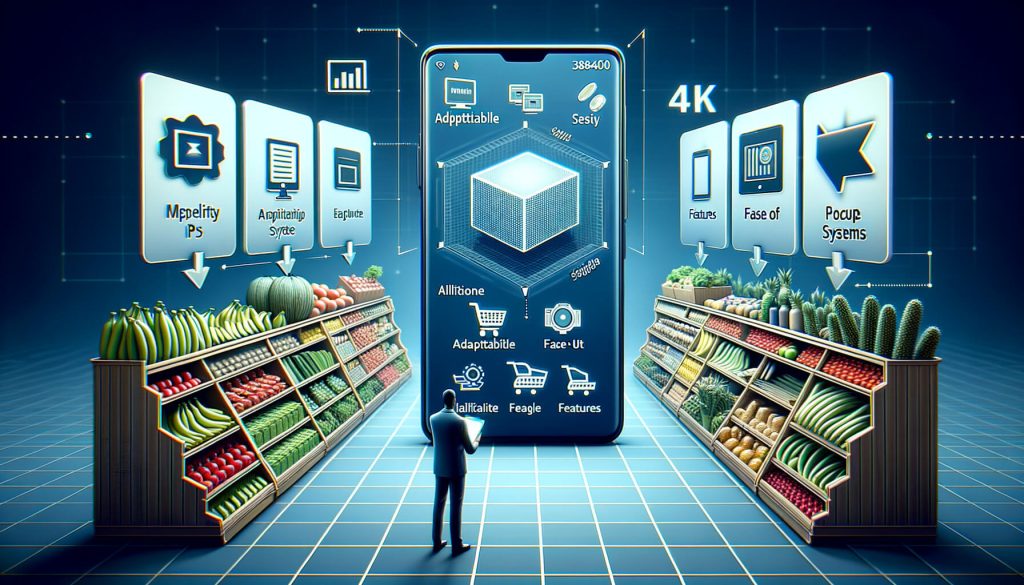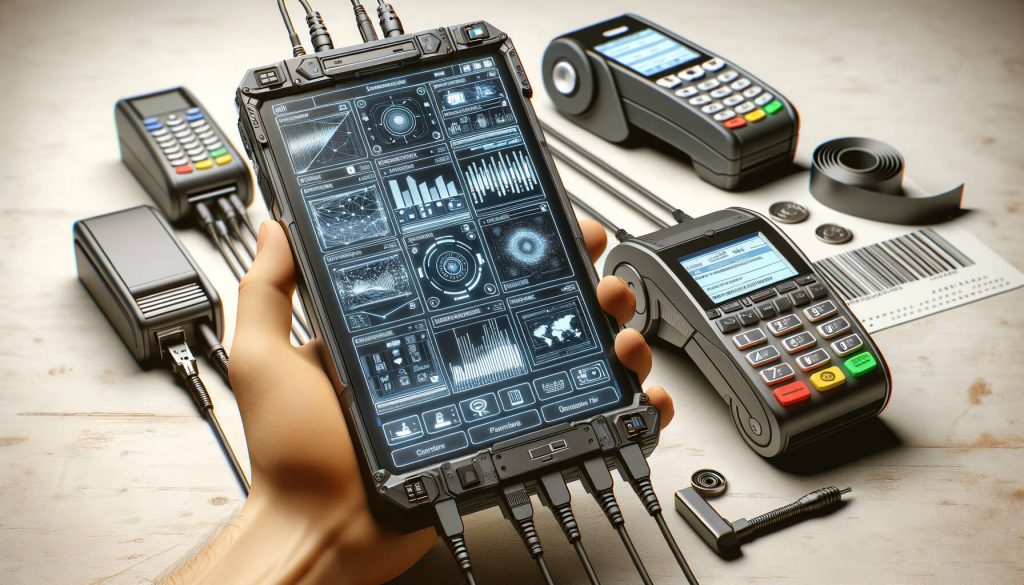In today’s fast-paced and technology-driven world, small grocers need to stay ahead of the curve to remain competitive. One way to do this is by adopting mobile point-of-sale (POS) systems. These innovative solutions offer a range of benefits that can revolutionize the way small grocers operate. From streamlining transactions to enhancing customer experience, mobile POS systems have become essential tools for success in the grocery industry.
In this comprehensive guide, we will explore the importance of mobile POS systems for small grocers and provide a step-by-step guide on how to set up and integrate these systems into your store.
Understanding Mobile POS Systems: What Are They and How Do They Work?

Before delving into the benefits and implementation of mobile POS systems, it is crucial to understand what they are and how they work. A mobile POS system is a portable device, such as a tablet or smartphone, that enables grocers to process transactions and manage inventory on the go. These systems typically consist of hardware, such as a card reader and barcode scanner, and software that integrates with the grocer’s existing point-of-sale system.
Mobile POS systems work by connecting to the grocer’s backend system, allowing real-time access to product information, pricing, and inventory levels. When a customer makes a purchase, the grocer can simply scan the items using the mobile device, process the payment, and update the inventory in real-time. This seamless integration between the mobile device and the backend system ensures accurate and efficient transactions.
Benefits of Mobile POS Systems for Small Grocers

- Increased Efficiency: Mobile POS systems eliminate the need for traditional cash registers and stationary checkout counters. This allows grocers to serve customers anywhere in the store, reducing wait times and improving overall efficiency.
- Enhanced Customer Experience: With mobile POS systems, grocers can provide personalized and efficient service to their customers. They can answer product inquiries, check inventory availability, and process payments on the spot, creating a seamless and convenient shopping experience.
- Improved Inventory Management: Mobile POS systems enable real-time inventory tracking, ensuring accurate stock levels and reducing the risk of overstocking or running out of popular items. This helps grocers optimize their inventory and minimize losses due to spoilage or obsolescence.
- Streamlined Checkout Process: Traditional checkout processes can be time-consuming and frustrating for customers. Mobile POS systems allow grocers to process payments quickly and securely, reducing checkout times and improving customer satisfaction.
- Cost Savings: Mobile POS systems eliminate the need for expensive cash registers and checkout counters, reducing upfront costs for small grocers. Additionally, these systems can integrate with existing point-of-sale software, minimizing the need for additional investments in infrastructure.
- Data Analytics: Mobile POS systems provide grocers with valuable data and insights into customer behavior, sales trends, and inventory performance. This data can be used to make informed business decisions, optimize pricing strategies, and improve overall profitability.
- Flexibility and Scalability: Mobile POS systems offer small grocers the flexibility to adapt to changing business needs. They can easily add or remove devices as their business grows or changes, ensuring scalability and cost-effectiveness.
Factors to Consider When Choosing a Mobile POS System for Your Grocery Store

When selecting a mobile POS system for your grocery store, several factors should be taken into consideration. These include:
- Compatibility: Ensure that the mobile POS system is compatible with your existing point-of-sale software and hardware. This will ensure a seamless integration and minimize disruptions to your operations.
- Ease of Use: Look for a mobile POS system that is intuitive and user-friendly. Your staff should be able to quickly learn and navigate the system without extensive training.
- Hardware Requirements: Consider the hardware requirements of the mobile POS system. Determine if you need additional devices, such as barcode scanners or card readers, and ensure they are compatible with the system.
- Security Features: Security is paramount when handling customer payments and sensitive data. Choose a mobile POS system that offers robust security features, such as encryption and tokenization, to protect customer information.
- Customer Support: Evaluate the level of customer support provided by the mobile POS system provider. Ensure they offer timely assistance and have a reliable support team to address any issues or concerns that may arise.
Setting Up a Mobile POS System: Step-by-Step Guide for Small Grocers

Setting up a mobile POS system for your grocery store involves several steps. Follow this step-by-step guide to ensure a smooth and successful implementation:
- Assess Your Needs: Determine your specific requirements and goals for implementing a mobile POS system. Consider factors such as the number of devices needed, integration with existing systems, and desired features.
- Research Providers: Conduct thorough research to identify reputable mobile POS system providers that cater to the grocery industry. Read reviews, compare features and pricing, and request demos or trials to evaluate the systems firsthand.
- Choose a Provider: Select a mobile POS system provider that aligns with your needs and budget. Consider factors such as cost, functionality, customer support, and scalability.
- Purchase Hardware: Once you have chosen a provider, purchase the necessary hardware, such as tablets, card readers, and barcode scanners. Ensure they are compatible with the mobile POS system.
- Install Software: Install the mobile POS system software on the devices. Follow the provider’s instructions for installation and configuration.
- Integrate with Existing Systems: If you have an existing point-of-sale system, ensure that the mobile POS system integrates seamlessly with it. This may require additional configuration or customization.
- Train Staff: Provide comprehensive training to your staff on how to use the mobile POS system. Familiarize them with the features, functions, and best practices to ensure a smooth transition.
- Test and Troubleshoot: Conduct thorough testing of the mobile POS system to identify any issues or glitches. Address these promptly to ensure a seamless customer experience.
- Launch and Monitor: Once the system is fully operational, launch it in your store. Monitor its performance closely and gather feedback from staff and customers to identify areas for improvement.
Integrating Inventory Management with Mobile POS Systems: Best Practices
Integrating inventory management with mobile POS systems is crucial for small grocers to optimize their operations and maximize profitability. Here are some best practices to consider:
- Real-Time Inventory Updates: Ensure that your mobile POS system updates inventory levels in real-time. This will help you avoid stockouts, improve order accuracy, and streamline replenishment processes.
- Barcode Scanning: Utilize barcode scanning capabilities to track inventory accurately. This will minimize manual errors and improve efficiency in managing stock.
- Automated Reordering: Leverage the data collected by your mobile POS system to automate the reordering process. Set up alerts or triggers that prompt you to reorder items when stock levels reach a certain threshold.
- Supplier Integration: Integrate your mobile POS system with your suppliers’ systems to streamline the ordering and replenishment process. This can help reduce lead times, improve order accuracy, and enhance overall supply chain efficiency.
- Product Categorization: Categorize your products in your mobile POS system to facilitate inventory management. This will enable you to track sales by category, identify top-selling items, and make informed decisions about product assortment and pricing.
Enhancing Customer Experience with Mobile POS Systems: Tips and Strategies
Mobile POS systems offer numerous opportunities to enhance the customer experience in your grocery store. Here are some tips and strategies to consider:
- Personalized Service: Use your mobile POS system to access customer information and preferences. This will enable you to provide personalized recommendations, discounts, or promotions based on their purchase history.
- Queue Busting: Use mobile POS devices to serve customers in line, reducing wait times and improving customer satisfaction. This is particularly useful during peak hours or busy periods.
- Product Information: Equip your staff with mobile POS devices to provide customers with detailed product information, such as ingredients, nutritional facts, or allergen warnings. This will help customers make informed purchasing decisions.
- Loyalty Programs: Integrate your mobile POS system with your loyalty program to reward customers for their purchases. Offer exclusive discounts or promotions to incentivize repeat business.
- Mobile Payments: Enable mobile payment options, such as contactless or digital wallets, to provide customers with a convenient and secure payment method. This will streamline the checkout process and enhance overall customer satisfaction.
Mobile Payment Options: Exploring Contactless and Digital Wallets
Mobile POS systems offer grocers the opportunity to embrace contactless and digital wallet payment options. These payment methods provide convenience, security, and speed for both customers and grocers. Here are some popular mobile payment options to consider:
- Contactless Payments: Contactless payments use near-field communication (NFC) technology to enable customers to make payments by simply tapping their mobile devices or contactless cards on the payment terminal. This eliminates the need for physical contact or the insertion of cards, making it a fast and hygienic payment method.
- Digital Wallets: Digital wallets, such as Apple Pay, Google Pay, or Samsung Pay, allow customers to store their payment information securely on their mobile devices. They can then make payments by simply tapping their devices on the payment terminal or scanning a QR code. Digital wallets offer convenience, security, and the ability to store multiple payment methods in one place.
- Mobile Apps: Some grocers develop their own mobile apps that integrate with their mobile POS systems. These apps allow customers to make payments, access loyalty programs, and receive personalized offers or discounts. Mobile apps provide a seamless and branded experience for customers, enhancing their loyalty and engagement.
Security and Data Protection: Safeguarding Your Mobile POS System
Security and data protection are paramount when implementing a mobile POS system. Grocers must take appropriate measures to safeguard customer information and prevent unauthorized access. Here are some best practices to ensure the security of your mobile POS system:
- Encryption: Ensure that your mobile POS system uses encryption to protect sensitive data, such as customer payment information. Encryption converts data into unreadable code, making it difficult for hackers to decipher.
- Tokenization: Implement tokenization, which replaces sensitive data with unique tokens. This ensures that even if a hacker gains access to the data, they cannot use it for fraudulent purposes.
- Secure Networks: Use secure networks, such as virtual private networks (VPNs), to transmit data between your mobile POS devices and backend systems. This will protect data from interception or unauthorized access.
- Regular Updates: Keep your mobile POS system software and hardware up to date with the latest security patches and updates. This will ensure that any vulnerabilities are addressed promptly.
- Employee Training: Train your staff on best practices for data security and fraud prevention. Educate them on the importance of strong passwords, avoiding phishing scams, and reporting any suspicious activities.
Frequently Asked Questions (FAQs)
Q1. What is a mobile POS system?
A mobile POS system is a portable device, such as a tablet or smartphone, that enables grocers to process transactions and manage inventory on the go. It typically consists of hardware, such as a card reader and barcode scanner, and software that integrates with the grocer’s existing point-of-sale system.
Q2. How does a mobile POS system work?
Mobile POS systems work by connecting to the grocer’s backend system, allowing real-time access to product information, pricing, and inventory levels. When a customer makes a purchase, the grocer can simply scan the items using the mobile device, process the payment, and update the inventory in real-time.
Q3. What are the benefits of mobile POS systems for small grocers?
Mobile POS systems offer increased efficiency, enhanced customer experience, improved inventory management, streamlined checkout processes, cost savings, data analytics, flexibility, and scalability for small grocers.
Q4. How do I choose the right mobile POS system for my grocery store?
When choosing a mobile POS system, consider factors such as compatibility with existing systems, ease of use, hardware requirements, security features, and customer support. Conduct thorough research, read reviews, and request demos or trials to evaluate the systems firsthand.
Q5. How do I set up a mobile POS system for my grocery store?
Setting up a mobile POS system involves assessing your needs, researching providers, choosing a provider, purchasing hardware, installing software, integrating with existing systems, training staff, testing and troubleshooting, and launching and monitoring the system.
Conclusion
Mobile POS systems have become essential tools for small grocers looking to stay competitive in today’s fast-paced retail landscape. These systems offer a range of benefits, including increased efficiency, enhanced customer experience, improved inventory management, streamlined checkout processes, cost savings, data analytics, flexibility, and scalability.
By following the step-by-step guide provided in this comprehensive article, small grocers can successfully implement and integrate mobile POS systems into their operations. With the right system in place, grocers can optimize their processes, provide personalized service, and stay ahead of the curve in the ever-evolving grocery industry.

